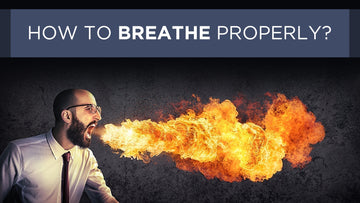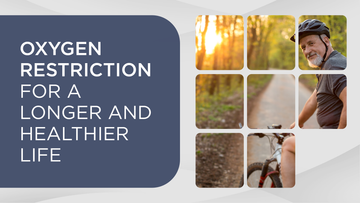
CO2 Therapy: What, Why, and How?
When we inhale, we take in oxygen. On the exhale, we blow off the excess carbon dioxide (CO₂) our body produces.
CO₂ Therapy is about optimizing the levels of both oxygen and carbon dioxide in the body. For most people, this means reducing oxygen intake and increasing their tolerance for CO₂.
This article focuses on the benefits of CO₂, but you can read more here about oxygen restriction and how it can support a longer, healthier life.
CO₂ Therapy Brochures
Why Practice CO₂ Therapy?
The main reason is that CO₂ Therapy enhances oxygenation and energy production. Despite popular belief that CO₂ is just a simple waste product, optimal CO₂ levels are actually essential for virtually every bodily function.
Our bodies crave oxygen—but carbon dioxide is what enables it to be effectively transported and used, from the moment it enters through our nose to its final role in cellular energy production in the mitochondria. Here’s how CO₂ plays a critical role in every step of this journey:
1. CO₂ Controls Breathing

It's not a lack of oxygen that triggers the next breath—it's the accumulation of CO₂. Chemoreceptors in the brainstem, our center for survival functions like temperature, heartbeat, and breathing, monitor CO₂ levels and signal the diaphragm to initiate inhalation when those levels rise. A low tolerance for CO₂ causes quicker, larger breaths—an unmistakable pattern of stress and anxiety.
2. CO₂ Keeps Airways Open

Optimal CO₂ levels stimulate the production of nitric oxide, which relaxes and widens the smooth muscles around the airways, keeping them open so air can flow easily into and out of the lungs.
3. CO₂ Keeps Blood Vessels Open

Once oxygen enters the bloodstream, CO₂ ensures that blood vessels stay relaxed and dilated—again by acting on the smooth muscle around the blood vessels, via nitric oxide—so that oxygen-rich blood can flow freely throughout the body.
4. CO₂ Helps Oxygen Release to Cells

When oxygen-rich blood reaches the tissues, CO₂ helps release oxygen from hemoglobin, making it available to the mitochondria—the cell's energy factories. The effect that CO₂ has on hemoglobin to release oxygen is called the Bohr effect.
5. CO₂ Protects Mitochondria

In the mitochondria, our cells' powerhouses, nutrients and oxygen are turned into energy. However, oxygen is highly reactive, and if the energy production is not controlled, the mitochondria will get damaged, causing oxidative damage. CO₂ acts as a natural antioxidant, helping to regulate this energy production and protect cells from stress and inflammation.
So, as we can see, in all the five steps of body oxygenation, carbon dioxide is the main facilitator. It is CO2 that paves the way for oxygen so that we can produce energy efficiently.
In all health issues, lack of energy is a major problem. Either the process is inefficient, so we produce too little, or we consume too much, or both. Like a company with low sales and too high costs.
Lower levels of CO2 are common in today’s society because of over-breathing and inactivity, which leads to restriction, friction, and resistance. This means we have to spend more of our resources on survival, and we have less energy to recover, repair, enjoy life, and personal growth.
Low energy, a racing mind, anxiety, pain, sleep problems, airway problems, heart and circulation issues, overweight, poor athletic endurance are some of the problems closely related to lower levels of CO2, and where CO2 Therapy could be beneficial.
How do you do CO2 Therapy?
There are a number of ways to do CO2 Therapy. The easiest way is simply to just breathe slower, by closing your mouth and making the exhale slightly longer than the inhale. Slowing down our breathing reduces the outflow of CO2 when we exhale.
Other types of CO2 Therapy include:
- Inhaling CO2, typically 50-200 times more than we normally inhale, for example, with our Cardihaler. Injecting CO2, for example, where you have scar tissue or cellulite. Immerse your skin in CO2 with a foot, hand, face, or whole-body CO2 bath, for example, using our Cardisuit. Insufflate CO2 rectally and vaginally.
- Another form of CO2 Therapy is HIIT, High Intense Interval Training, as the intense training increases the CO2 levels to the point where the lungs can't manage to blow off all the excess CO2 produced.
- ERB, Exercise with Restricted Breathing, for example, nasal breathing, slow breathing, breath holds, and training mask, is another way of doing CO2 Therapy.
- And finally, BFR, Blood Flow Restriction training, or Kaatsu, is also CO2 Therapy. Restricting the blood flow to the working muscle prevents the CO2 from leaving the muscle. The muscle's response to higher CO2 levels is to grow bigger and stronger. Studies show that muscles exposed to CO2 mimic aerobic exercise, with muscles growing bigger, mitochondria increasing in size and number, and more blood vessels forming to support the muscle.







